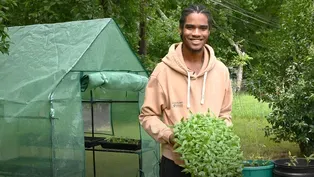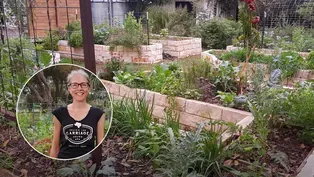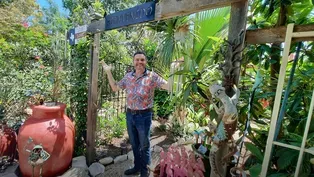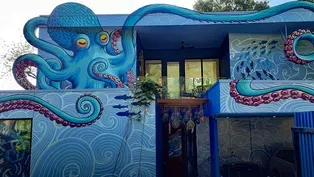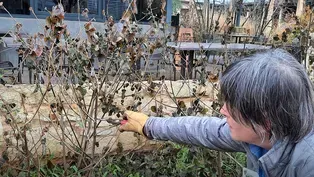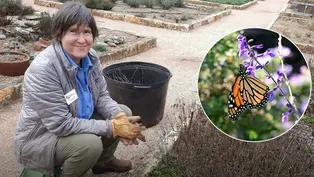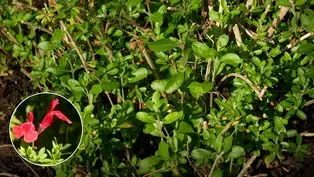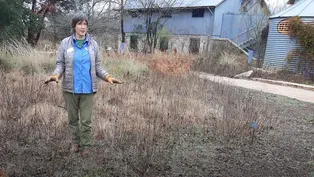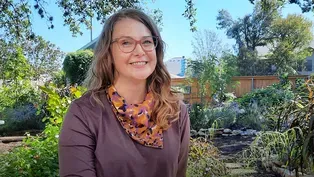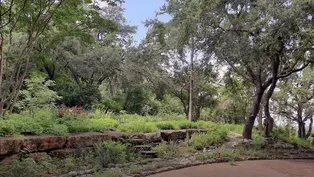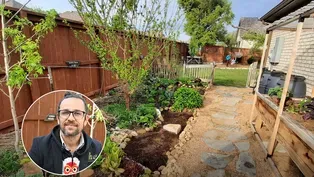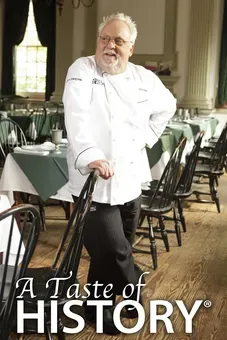
Hill Country Habitat Romance
Clip: Season 28 | 8m 49sVideo has Closed Captions
James Truchard created diverse habitats to offset a future of climate changes.
Soil under his fingernails grounds James Truchard to the land he loves. In every season, he celebrates unfolding flowers and ripening seeds for wildlife that frolics and feeds. Over decades, his vision and respect for Hill Country resources continues to respond to climate challenges.
Problems with Closed Captions? Closed Captioning Feedback
Problems with Closed Captions? Closed Captioning Feedback
Central Texas Gardener is a local public television program presented by Austin PBS
Support for CTG is provided by: Lisa & Desi Rhoden, and Diane Land & Steve Adler. Central Texas Gardener is produced by Austin PBS, KLRU-TV and distributed by NETA.

Hill Country Habitat Romance
Clip: Season 28 | 8m 49sVideo has Closed Captions
Soil under his fingernails grounds James Truchard to the land he loves. In every season, he celebrates unfolding flowers and ripening seeds for wildlife that frolics and feeds. Over decades, his vision and respect for Hill Country resources continues to respond to climate challenges.
Problems with Closed Captions? Closed Captioning Feedback
How to Watch Central Texas Gardener
Central Texas Gardener is available to stream on pbs.org and the free PBS App, available on iPhone, Apple TV, Android TV, Android smartphones, Amazon Fire TV, Amazon Fire Tablet, Roku, Samsung Smart TV, and Vizio.
Providing Support for PBS.org
Learn Moreabout PBS online sponsorship- I pretty much have flowers blooming every time of the year except after very hard freezes.
Always native plants are cutting down the need for resources, keeping as much green as possible.
Hi, I'm Jim Truchard.
Back in 1995, I was looking for a new lot, a new home, and I selected this lot, which was bare rock.
And over the years, I've added soil and the plants that we now see in my garden.
I grew up on the farm.
We had a very low carbon print.
We did not... Footprint.
We didn't have electricity.
We grew our own crops.
We used composted manure to fertilize the crops.
My shirts were made out of feed sacks, literally.
There were feed sacks, that had... One I remember had monkeys on it.
So and we made balls with the string that you got.
And so it was very much conservation and saving things and recycling and reusing.
Now things like having the garden with lots of growing plants can move you back in that direction a little bit.
Pretty much started with bare rock.
And I researched native plants and primarily use natives, but I do add others from time to time.
I like well adapted things.
I also love the rocks, the natural stone, like Willie Nelson would say, old folk, Fords and natural stone.
So I've used stones generously around the property to make trails to build retaining walls, to give the character I like and the feel of the Hill Country.
The retaining walls, at first I was trying to find stones from other properties, but then I realized I could dig up the stone on site.
It was sitting right on the surface.
And some of them appealed to me as potentially as art, so now I've made them into art pieces.
But I do have the stones that were carved by nature and maybe represent some animal or bird.
Even the Loch Ness Monster, for example, so basically we have nature's art.
And then I scrounged for soil from a variety of places to backfill the walls and create the depth of soil that I needed to grow plants.
I follow a fairly casual approach.
Plants will come up in a variety of places, so.
And also I have rock squirrels here who love the big rock walls to build their homes and they bring buckeye, scarlet buckeye, which is one of my favorite plants.
Very slow growing.
They bring buckeyes up here and plant them for me.
So over the years I have a combination of plants finding their own spot and me learning where to plant them.
I found the best spots, whether it be purple coneflower, whether it be columbine, whether it be many other kinds of plants, we'll find their favorite spot with the right amount of shade.
Of course, with time, I got the trees have grown, so I've got more shade than I did when I started.
Well, the river fern, I planted what I call the forest, and now it's surrounding the house.
So it found its own place.
I did not plant it there.
One of the things I try to grow was the Nuevo Leon Sage and it when it gets wet feet, it dies.
It just cannot stand our combination of rain and then heat afterwards.
So that's one that I did not have luck with.
Growing up on the farm, I think, is a good lesson about how to deal with setbacks and in business as well.
So on the farm you got the adverse weather conditions that the crop may fail.
Or you planted too early and you have to replant.
These are the kind of lessons that help you in business to be adaptable to adverse things and take them in stride.
In the dead of winter, when a lot of the plants have died back and I can see the stones.
So the stones are always there and they're always beautiful.
It makes winter a better time of year than it would be otherwise 'cause the stones don't mind the cold.
Then there's a little hiatus for a month or two.
But some of my favorite are the plants that already were growing here, like the rock roses, the twistleaf yucca, the red buckeye, the cedar sage.
These are all local natives and they're some of my very favorite plants and they bloom different times a year.
I wanted to have pretty much blooms all year.
Even in the summer we have Texas star hibiscus which are just lovely.
And the hummingbirds and that love, love the star hibiscus.
So I pretty much have the same level of blooms in the summertime that I have year round.
The batface is another of my favorite, another of the hummingbirds' favorites as well.
When the hummingbirds come through in September, especially in dry years, the batface is one of their favorite flowers.
I suppose they're familiar with it since it grows in Mexico and they'll stop and enjoy those flowers.
And I also, to some extent, one of every kind of thing, a pond, a firepit, and given that I started with a side of the hill lot, it made a lot of sense to layer and terrace it in a way which would create different natural habitats.
Of course, there's the armadillos that come there, our neighbors, so we live with them even though they dig holes and dig out plants you just planted, so.
But they're our neighbors, so we live with them.
So creating habitats, creating spaces like the space we're sitting in here as an example, have a hammock here too, so I can doze and watch the hummingbirds on the bee balm.
Or we might say, let the world turn on its own for a while.
We had a requirement that all the water needed to go to the front, subdivision development requirement.
And so the rainwater tank is part of that to capture rainwater instead of letting it run downhill on the neighbors below.
The dry bed is designed to carry the water to the front of the house.
The book is a dedication to my first wife who passed away.
I had something like 125,000 pictures so I could select.
I didn't even have to Photoshop them, but I could find one.
I call it the monkey in a typewriter strategy.
With enough pictures, there's a good one in there somewhere.
All were taken in the garden over a ten-year period of time.
The soil is still under our fingernails, so back to the soil.
Even though I did a lot of high tech work getting out and it's relaxing.
Things that used to be work when you were a kid and you're shoveling whatever now become relaxing and a way to escape.
Growing Community: Body and Soul
Video has Closed Captions
Lenny West found his anchor and mission in providing fresh vegetables to food desert neighbors. (6m 18s)
Native Plant Garden in HOA: Martin Byhower
Video has Closed Captions
A California-to-Texas environmentalist helps neighbors garden for wildlife in extreme weather. (8m 42s)
Permaculture Design: Raised Beds and Food Forest
Video has Closed Captions
Limestone raised beds and a mandala-designed food forest honor resourceful permaculture tenets. (9m 15s)
Creating Moods in a Regular Backyard
Video has Closed Captions
Imagination, creative reuse, and spirited fun turned a backyard into a sensory voyage. (7m 41s)
Video has Closed Captions
New gardener Nancy Hall relied on plants–adapted and native–to teach her their ways. (7m 49s)
Artistic Collaboration Goes with the Flow
Video has Closed Captions
When rainwater runoff plagued a family’s home, they plunged into a whimsical makeover. (8m 25s)
Winter Pruning: Wax Mallow for Spring’s Spiderworts
Video has Closed Captions
See how to cut back wax mallow (turk’s cap) to show off spring-blooming spiderworts. (3m 25s)
Winter Pruning: Mealy Blue Sage
Video has Closed Captions
See where to cut back old stalks on perennial mealy blue sage. (3m 16s)
Video has Closed Captions
Learn how to prune this evergreen woody shrub/subshrub. (4m 47s)
Video has Closed Captions
See why to progressively prune grasses and herbaceous perennials. (1m 35s)
Garden Makeover Grows New Friends and Career
Video has Closed Captions
Jennie Ostertag broke a few shovels changing her yard and life’s path. (9m 18s)
Video has Closed Captions
James Truchard created diverse habitats to offset a future of climate changes. (8m 49s)
Drought Design: Change of Plans & Plants
Video has Closed Captions
Mistakes led new gardeners back to the drawing board with native plants. (8m 55s)
Side Yard Garden Permaculture Design
Video has Closed Captions
A narrow side yard supports food and flowers with permaculture techniques. (8m 1s)
Front Yard Native Plant Wildlife Habitat
Video has Closed Captions
Removing lawn for native plants brings pollinators to a young couple’s front yard. (9m 35s)
Providing Support for PBS.org
Learn Moreabout PBS online sponsorshipSupport for PBS provided by:
Central Texas Gardener is a local public television program presented by Austin PBS
Support for CTG is provided by: Lisa & Desi Rhoden, and Diane Land & Steve Adler. Central Texas Gardener is produced by Austin PBS, KLRU-TV and distributed by NETA.
